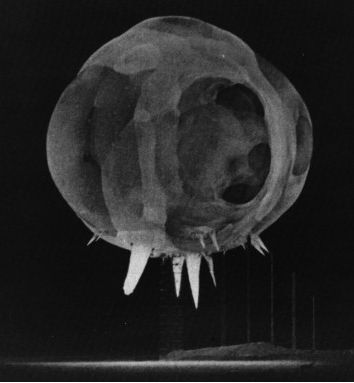by Larry
February, 2010The Little Nuclear War SolutionJoking aside, Alan Robock and Owen Brian Toon, in the January 2010 issue of "Scientific American," Vol. 302, Number 1, pages 74-81, propose, based on their research, that a limited or regional nuclear war of the kind and size now feasible between India and Pakistan would create such cooling and limitations in the amount of sunlight reaching Earth's surface that it would for several years have severe effects on global agriculture, leading to massive food shortages. One consequence, however, would be that, for a period, the documented global warming trend would be reversed.
The article's authors hypothesize that a number of scenarios might result in limited nuclear wars of sufficient scope to have this outcome, but the most likely participants would be Pakistan and India, since they possess ample atomic weapons, have between them an uneasy peace coupled with great distrust, and, in the event of a conventional conflict, have incentive to use the nuclear option, lest either be overrun by opposing forces or suffer the devastating effects of an enemy's nuclear first strike. If all their atomic weapons were employed in such a conflagration, the resulting firestorms apparently would be sufficient to bring about catastrophic loss of crops and so starvation in much of the world's population. In decades past, quite large stores of reserve grain might have been used to avoid massive food shortages in that type global emergency. Recently, however, little grain reserves or other stockpiled foodstuffs remain. They would be quickly exhausted in a crisis. Robock's and Toon's models show that, within two days of a local atomic war, the smoke from resulting firestorms would reach the troposphere where solar radiation would heat the smoke particles, lifting them into the stratosphere. Rain occurs at lower levels of the atmosphere, so the soot would remain aloft for up to a decade and in a few weeks would have dispersed around the globe. Unlike the effects of a single massive volcanic eruption (the sulfate particles from which are transparent and also do not rise as high into the stratosphere), which can lower temperatures mildly for a couple years, smoke from the secondary combustions a nuclear war would set off is anticipated to bring summer frosts in normally temperate areas as well as a general drying, darkening, and cooling of the planet. According to these scientists, besides the tens of millions who might be killed by such a war's detonations and radioactivity, the combination of drought, failure of crops to thrive (due to reduced sunlight), killing frosts, and, ironically, increased exposure to ultraviolet radiation (because upper atmosphere ozone would be depleted worldwide, as is common now mainly over Antarctica), food yields would decline rapidly and leave an estimated one billion people without sufficient nourishment for survival, creating as well immense threats to local, regional, and international stability. Is this outcome truly possible? Robock's and Toon's argument is persuasive. Is it likely in the particular instance of a war between Pakistan and India? I do not personally think so. Nonetheless, it is a risk horrendous enough that humankind would do well to minimize further the chances of its ever occurring. It would be irresponsible to do otherwise. If we do not, our present geopolitical mini-detente of multiple states facing each other down in fragile nuclear brinkmanship may at some point be tipped by two or more local adversaries into the kind of real test Robock and Toon have so far just been modeling. It is a test we could simply not afford to flunk. Meanwhile, though, nations around the world are increasing their caches of atomic ordnance. Some are even talking of having further nuclear tests. The "Nuclear Club" of countries possessing such weapons is also increasing, now up to nine. Many others, such as Japan, Turkey, South Africa, and Saudi Arabia are thought capable of developing fissionable weapons and likely would do so if aggressive neighbors, such as North Korea or Iran, were thought to pose a serious nuclear threat. The bottom line is that, whether the hazard to Mother Nature's tried and true equilibrium is that we inadvertently get things a little too hot or a little too cold, once we have disrupted the delicate natural order, then, willy-nilly, it will be incumbent on us to take over from her and do the job as well as she has done for billions of years. Yet, chances are, Mother Nature's act will be a hard one to follow. Difficult as it may be for our species to assure, letting well enough alone now may be far easier than trying to control Earth's subtle balance of systems on our own. |
